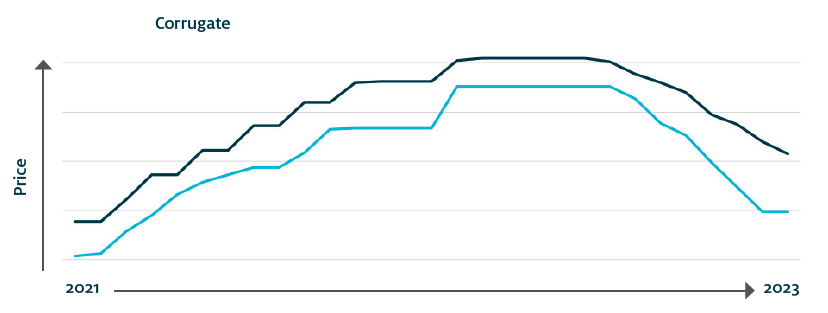Packaging, as you may know, isn’t just about boxes and containers. It’s a complex interplay of materials, costs, and supply chains.
A brief overview reveals that packaging is primarily composed of two main materials: cardboard (or corrugate) and plastic. Cardboard, with its corrugated layers, forms the basis of boxes, while plastic materials such as tapes and pallet wrap complement the packaging landscape.
For most, the focus lies in two key indices: the state of the corrugate market and the state of the plastic market. Over the years, stability prevailed until the arrival of the pandemic, which ushered in an unforeseen era of change. The sudden surge in online shopping led to an unprecedented demand for packaging materials. It’s no surprise that giants like Amazon thrived during this period, but this online shopping boom carried hidden consequences.
Each individually wrapped item shipped meant additional cardboard usage, driving up demand. The result? A rapid increase in cardboard prices, accompanied by supply shortages. Just as the industry began to find its footing, the Russian war emerged as a new obstacle. Rather than demand, supply was now in jeopardy, leading to further price hikes and supply imbalances. What followed was a period of uncertainty, where pricing fluctuations left businesses in a challenging position.
As the months rolled by, the packaging industry witnessed another twist in the tale. The cost of living crisis took centre stage, impacting consumer spending habits. Packaging suppliers anticipated a surge in demand as the festive holiday season approached, with preparations usually beginning as early as September. However, this time around, the anticipated demand never materialised to the expected extent. The result was a drop in demand that rippled through the packaging supply chain. This tale of fluctuating fortunes paints a complex picture of the packaging industry’s journey through the pandemic and beyond. While the broader narrative of cost-of-living crises and inflation has gripped the public’s attention, its impact on packaging is nuanced. The ebb and flow of demand, the precarious balance of supply, and the ripples of consumer behaviour all play a role in shaping the industry’s trajectory.
As we navigate these complex waters, it’s important to acknowledge the intricate dance between economic forces and industry dynamics. Packaging, while often relegated to the background, remains an essential component of our lives, affecting everything from the goods we receive to the waste we produce. This tale of resilience, adaptation, and change underscores the integral role packaging plays in the modern world.



